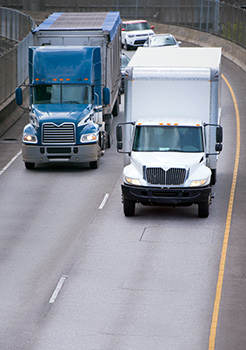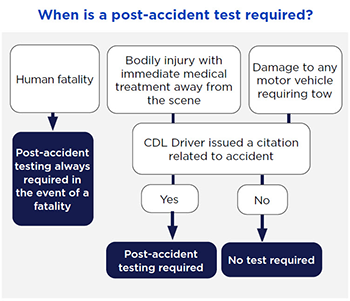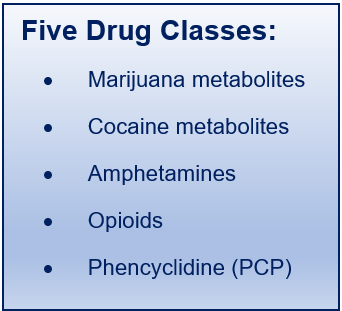Drug and alcohol requirements for organizations with CDL drivers

Organizations that operate vehicles which require a Commercial Driver’s License* (CDL) to operate are subject to the Federal Motor Carrier Safety Administration’s (FMCSA) drug and alcohol testing rules and regulations (§382). This article will provide an overview of what you need to know if you are employing CDL drivers.
As an employer you are required to establish a drug and alcohol policy, make educational materials available, and designate a person that CDL drivers may approach with questions about the policy.
Drug and alcohol policy
Reach out to your testing provider for a sample DOT-regulated drug and alcohol policy to help you get started. Legal council should review the policy. At a minimum the drug and alcohol policy should include but not be limited to:
- Policy statement
- Personnel subject to testing
- Participation a requirement of employment
- Prohibited behavior
- Circumstances for testing
- Behavior constituting refusal to test
- Consequences for drivers that fail a test
- Testing procedures
- Consequences of controlled substance use and misuse of alcohol
- Designated employer representative
- Effects of controlled substance and alcohol
- Reference §382.601 for more information
The drug and alcohol policy must be communicated and provided to covered employees, and those managing them. This is typically done during the driver orientation process and best practice is to review the policy annually thereafter.
Types of drug and alcohol testing
Under FMCSA there are circumstances in which a driver is required to be given a drug and alcohol test. The first circumstance is during pre-employment screening and the test is only for controlled substances (drug). When a pre-employment drug test is performed, the new driver cannot be released to drive until results have physically been received from the testing provider.
If a driver is involved in a vehicle accident while driving a Commercial Motor Vehicle, they could be required to submit to a post-accident drug and alcohol test. A driver is required to be tested if there is a fatality, if there is bodily injury where immediate treatment is provided away from the scene and a citation issued, or vehicle is towed away, and a citation is issued. See part §382.303 for guidance regarding how soon testing must be completed after the accident.

Employers are required to randomly test CDL drivers at a minimum annual percentage rate per calendar year (January 1 – December 31), as dictated by FMCSA. The annual percentage rate set by FMCSA is apt to change from calendar year to calendar year.
Currently, the annual percentage rate is 10% for alcohol and 50% for controlled substances (drugs). The FMCSA may adjust testing percentages based on actual positive testing rates from random tests the previous year.
CDL drivers must be in a separate random pool from any other random drug and alcohol pool. If an employer has very few drivers they can elect to be included in a consortium, which is a pool of other CDL drivers. As an employer you may elect to pull your drivers at random to be tested or allow your consortium/third party administrator to coordinate this process.
An employer may require a driver to submit to an alcohol and/or drug test when reasonable suspicion exists that the driver may be under the influence of alcohol and/or drugs. Individuals that supervise a CDL driver are required to be trained on what to look for in order to make the determination to have a driver tested for reasonable suspicion.
Supervisor training
Those that supervise drivers are required to receive an hour of training on alcohol misuse and receive an additional hour of training on controlled substance use. The training shall include physical, behavioral, speech, and performance indicators of probable alcohol misuse and use of controlled substances. FMCSA does not require any refresher training, but it is considered a good practice.

What is considered a failed test?
As an employer, you are required to report any drug and alcohol violation into the FMCSA Drug and Alcohol Clearinghouse. A blood alcohol concentration of .04 or greater or positive result of any of the five drug classes is considered a positive test. A positive drug test is reviewed by a Medical Review Officer (MRO), which either confirms or denies the positive drug test. MROs are required to report within two business days of making a determination or verification of the test.
A refusal to submit to a drug and/or alcohol test or altering a test is a violation and treated the same as a positive test, in that the driver is immediately removed from driving any commercial motor vehicle (CMV) and the violation is reported into the FMCSA Drug and Alcohol Clearinghouse.
Returning to driving a commercial motor vehicle
Depending on procedures outlined in the employer’s drug and alcohol policy, a driver may be terminated or transferred to a position not requiring driving of a CMV.
For a driver to return to driving a CMV after testing positive on a drug and/or alcohol test, the driver will need to be evaluated by a Substance Abuse Professional (SAP) and participate in/complete the treatment program prescribed. That driver will also need to pass a drug and/or alcohol return-to-duty test.
After returning to driving the driver will be required to participate in a documented follow up testing schedule, which is created by the SAP and subject to at least six unannounced follow-up tests in the first 12 months. The driver is also subject to follow up tests during the 48 months following the first 12-month period. This is referred to in the FMCSR as the return to duty process.
Once a driver has successfully completed the return to duty process the employer must report it in the FMCSA Drug and Alcohol Clearinghouse.
Drug and Alcohol Clearinghouse Checks
During the hiring process and at least annually thereafter an employer is required to check the FMCSA’s Drug and Alcohol Clearinghouse for reported drug and alcohol violations. Drivers who have violations and have not completed their return to duty program and testing (§391.23 and §40.25) cannot drive a CDL vehicle. Refer to our “Drug and Alcohol Clearinghouse” bulletin for more information on the Clearinghouse.
Record Retention
As an employer of CDL Drivers, you are required to maintain records in a secure location with controlled access. Record retention varies depending on type of record. This can be five years, two years, one year or indefinite. Please refer to §382.401 in the FMCSR for specifics on retention of records.
